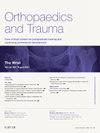注意缝隙:创伤后骨缺损的处理
Q4 Medicine
引用次数: 0
摘要
骨缺损是骨科面临的一个重大挑战,它可以由各种原因引起,包括创伤、感染、肿瘤或手术切除。这些缺陷可以导致显著的功能损伤和残疾,特别是当它们被归类为临界大小的缺陷时。骨缺损的治疗方式受多种因素的影响,如缺损的大小、邻近软组织的状况以及患者的具体考虑因素,包括年龄和合并症。治疗选择包括植骨技术、牵张成骨和Masquelet技术,每种技术都有其优点和局限性。最近的进展已经改进了手术技术和生物材料,促进了肢体的保留和功能恢复。新兴趋势突出了治疗方法的结合,如诱导膜技术和钛网笼的使用,通过提供稳定性和促进血管长入来提高愈合效果。骨组织工程的创新方法也为具有临界尺寸缺陷的骨科创伤患者提供了优化治疗的希望。未来的研究方向必须集中在定制治疗方案,以满足个体患者的需求,同时整合先进的骨组织工程技术,以提高愈合和恢复功能。本文章由计算机程序翻译,如有差异,请以英文原文为准。
Minding the gap: management of bone defects after trauma
Bone defects which constitute a major orthopaedic challenge can arise from various causes, including trauma, infection, tumours, or surgical resections. These defects can lead to significant functional impairment and disability, particularly when they are classified as critical-sized defects. Treatment modalities for bone defects are influenced by factors such as defect size, the condition of adjacent soft tissue, and patient-specific considerations including age and co-morbidities. Therapeutic options include bone grafting techniques, distraction osteogenesis, and the Masquelet technique, each with its advantages and limitations. Recent advancements have improved surgical techniques and biomaterials, facilitating limb salvage and functional restoration. Emerging trends highlight the combination of treatment methods like the induced membrane technique and the use of titanium mesh cages, which enhance healing outcomes by providing stability and promoting vascular ingrowth. Innovative approaches in bone tissue engineering also offer promise in optimizing treatment for orthopaedic trauma patients with critical-sized defects. Future directions in research must focus on tailoring treatment options to individual patient needs while integrating advanced bone tissue engineering techniques to improve healing and restore functionality.
求助全文
通过发布文献求助,成功后即可免费获取论文全文。
去求助
来源期刊

Orthopaedics and Trauma
Medicine-Orthopedics and Sports Medicine
CiteScore
1.00
自引率
0.00%
发文量
57
期刊介绍:
Orthopaedics and Trauma presents a unique collection of International review articles summarizing the current state of knowledge and research in orthopaedics. Each issue focuses on a specific topic, discussed in depth in a mini-symposium; other articles cover the areas of basic science, medicine, children/adults, trauma, imaging and historical review. There is also an annotation, self-assessment questions and a second opinion section. In this way the entire postgraduate syllabus will be covered in a 4-year cycle.
 求助内容:
求助内容: 应助结果提醒方式:
应助结果提醒方式:


